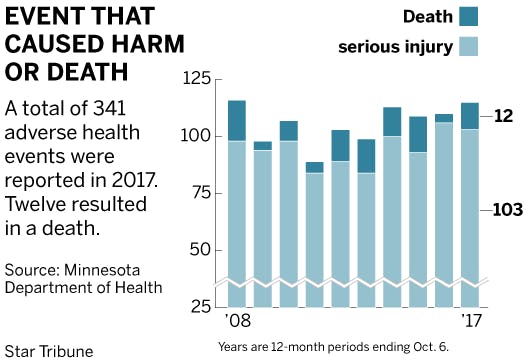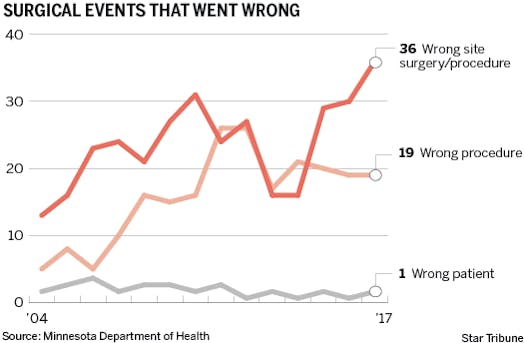Minnesota hospitals saw an increase last year in errors such as fatal or disabling patient falls and surgeries on the wrong body parts, as well as a cluster of medication errors related to the use of epinephrine to treat allergic reactions, cardiac arrests and other conditions, according to a state report released Thursday.
While patients are safer overall as a result of Minnesota's pioneering public accounting of hospital errors, state Health Commissioner Jan Malcolm said the increase suggests a need for "renewed focus." The 341 reportable adverse events in the 12-month period ending Oct. 6 was an increase from the 336 events reported by Minnesota hospitals and surgery centers in 2016.
"We don't find that good enough," Malcolm said.
The number of reportable errors, dubbed "never events" because they are preventable, has increased for four years. The errors last year contributed to 12 deaths and 103 disabling injuries.
Hospitals reported 36 surgeries or procedures to the wrong body parts, the most since the state started reporting adverse events in 2004. Many involved spinal procedures on the wrong side of the back or at the wrong vertebrae.
Hospitals developed standard "timeout" procedures over the past decade — pauses that doctors use to ensure they have the right patients, procedures and body parts before making incisions — to avoid scenarios such as the removal of the wrong kidney that occurred at Methodist Hospital in 2008.
But the latest report showed errors that occurred in the absence of time outs. In other cases, time outs were done incorrectly. In 41 percent of the wrong-site errors, for example, doctors did not physically mark the operation sites in ink for verification.
"It takes less than 60 seconds when done properly," said Rachel Jokela, who directs the adverse events program for the state Health Department. "It should be done, in its entirety, for every patient, every procedure, every time."
While the timeout is designed to be deliberate and to prevent overconfidence, doctors have done it for so long that they might be getting careless, Jokela said. Adverse events are rare, considering the more than 3 million procedures and surgeries performed by reporting hospitals last year.
State hospital leaders are going to revisit the timeout procedures, said Dr. Rahul Koranne, chief medical officer for the Minnesota Hospital Association, which released the adverse event data along with the Health Department.
More requirements have been added to the timeout — recently doctors were discussing adding fire prevention checks to the process — which could distract from its core purpose, he said.
"When it gets down to the final step, before putting the scalpel to the patient's skin, what does the nurse and the surgeon really need to focus on?" he said.
Minnesota was the first state to publicly report when hospitals committed any of two dozen adverse events. Now, five states do so.
Hospitals use the system to share with one another the causes of errors and solutions. Details rarely become public, unless patients or families sue or state or federal disciplinary agencies investigate.
A federal Medicare investigation detailed a 2016 error at Abbott Northwestern Hospital in Minneapolis, for example, in which a nurse administered a dangerous amount of epinephrine into a patient's bloodstream instead of into the patient's muscle.
It wasn't an isolated incident. Epinephrine errors were reported in prior years and in the adverse event report for 2017, prompting the Health Department to issue a safety alert regarding the drug.
Douglas County Hospital in Alexandria reported the only fatal medication error in the state last year, though there were 10 that caused serious injuries. The death also was related to epinephrine, and it prompted the hospital to restrict personnel who can handle the drug, said Bonnie Freudenberg, the hospital's director of quality.
Hospitals reported no physical assaults on patients for the first time in five years, but three sexual assaults were reported. Two occurred at the University of Minnesota Medical Center. Details of one became public when a family sued; the case involved a mentally unstable patient in the emergency department who entered the room of a 15-year-old girl and fondled her.
Large hospitals with the most patients predictably accounted for most of the errors. Mayo Clinic reported 39, the University of Minnesota had 26, and Abbott had 19.
Falls accounted for five deaths and 77 severe injuries in Minnesota hospitals last year. That was the second-highest total since 2008.
Hospital leaders said falls are a challenge and continue to happen despite the use of safer beds, bed rails, grab bars, floor mattresses and patient motion alarms. Increases in patients suffering dementia have added challenges. St. Joseph's Hospital in St. Paul had only reported 11 falls from 2004 to 2016, but the hospital reported five last year.
Mayo is studying an automated system that identifies specific movements in bedridden patients and predicts when they are attempting to get up. But Dr. Timothy Morgenthaler, chief patient safety officer for the Rochester hospital, said the next solution might involve old-fashioned conversations in which doctors explain the hazards of patients trying to get up when they think they are better.
"Some of these falls with injuries are occurring almost when a person is getting ready to go home," he said. "They're feeling close to their independent selves."
Jeremy Olson • 612-673-7744

University of Minnesota police arrest 9 after pro-Palestinian encampment set up on campus
2 dead in Lino Lakes, no known threat to public, police say
Teen charged with murder in deadly St. Paul shooting last month






